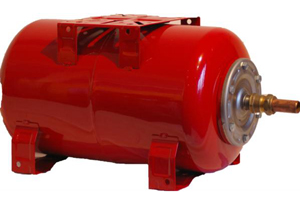Membrane tanks started to be used in our country after 1990 years. With the spread of natural gas, the use of these tanks has increased rapidly. Today, almost every boiler room has a membrane tank. Membrane tanks have become a standard part of both heating systems and booster systems. In vehicles such as floor heating, it is directly integrated into the product.
Membrane tanks are given a variety of names on the market: membrane tank, expansion tank, closed expansion tank, balance tank and the like. The basic features are the same, but different names are given according to the sector in which they are used and the intended use.
Expansion tanks They are used in heating systems to meet the volumetric change of the heated water. In sanitary installations, they are used to keep the static pressure generated by the pump at the level of use and to control the changes in the flow rate of water.
If the expansion vessels are correctly designed while the system is installed, it prevents sudden pressure changes and prolongs the life of the pump and fittings. Tanks and membranes are designed to be compatible with each other. Water does not come into contact with the tank in any way inside the membrane. Therefore, expansion tanks can be used both in heating and cooling installations and sanitary installations.
Expansion tanks, issued by the Ministry of Labor and Social Security, Health and Safety Conditions in the Use of Work Equipment Regulations, Annex 3 Maintenance, Repair and Periodic Inspection Related Issues, Pressure Vessel and Installations is described in the article.
The principle of hydrostatic tests has been generally adopted in the periodic inspection and control of pressure vessels and expansion tanks. These tests must be performed at least once a year. During tests, if there is no contrary provision in the standards, 1,5 multiples of operating pressure is applied.
During the periodic inspection and control of expansion tanks, the following legal regulations are taken into consideration:
- Regulation on Pressure Equipment
- Implementing Regulation on Portable Pressure Equipment
- Implementing Regulation on Simple Pressure Vessels
In addition to the criteria in the regulations mentioned, the following standards are taken into consideration during the inspection and controls:
- TS 1203 EN 286-1 Tanks - Simple - Non-flammable - Pressurized - Designed to store air or nitrogen - Part 1: Pressure tanks for general purposes
- TS EN 1012-1 Compressors and vacuum pumps - Safety rules - Part 1: Air compressors
- TS EN 13445-5 Pressure receptacles - Non-contact - Section 5: Inspection and testing
Periodic inspection of expansion tanks must be carried out by mechanical engineers, mechanical technicians or high technicians. Their information should be recorded electronically in the Ministry of Labor and Social Security.
The TÜRCERT certification body provides conformity assessment, certification and training services, while providing testing and inspection services. Do not hesitate to contact the experienced managers and employees of the TÜRCERT certification body for further information and inspection of expansion tanks.

